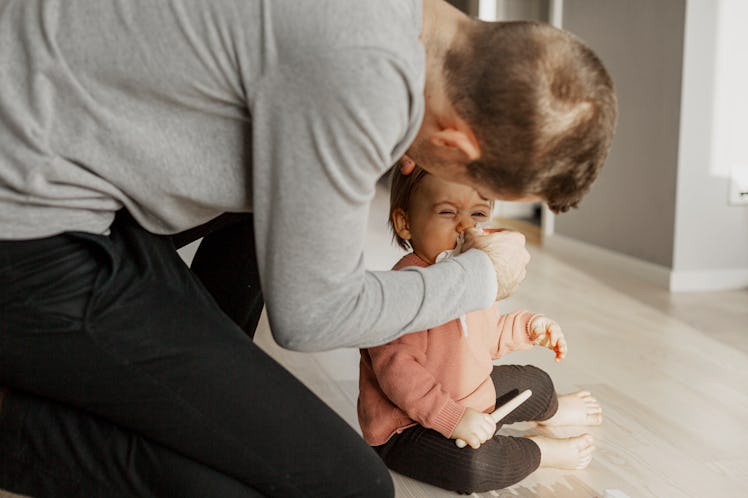The Best Way To Safely Get Rid Of Mucus Or Baby Snot
Mucus is disgusting and your child's face is laminated in it. Be proactive about the problem.

In the world of bodily liquids, mucus may not top the list of the grossest secretions. But it is pervasive, annoying, and too relevant for comfort if you have a baby. At some point — and almost certainly in the depths of winter — you’re going to wonder how to get rid of mucus in your baby’s throat. That’s because a baby’s runny nose is a constant — snot is essentially a filtration system that helps flush harmful bacteria and viral infections from the body. So all that mucus is keeping them healthy. That’s nice, but it doesn’t make it any less gross, which is why knowing how to get mucus out of a baby’s throat, and clear a runny nose, is a crucial skill for parents. Herewith, everything you need to know about how to manage all that mucus, from saline drops for babies to the delicate art of suction.
Lucky for parents, babies have secreted snot like upright banana slugs since babies existed, and tried-and-true methods have existed for generations.
How to Get Mucus Out of Baby’s Throat
Start simple. You can wipe the nose with a wet cloth works, which works especially well when paired with a little petroleum ointment to help ease skin irritation. Parents can make a game of blowing noses, too, teaching a child as young as 1 to do it themselves by associating the act with songs or silly noises. The discomfort that comes with thicker snot and mucus can also be alleviated with a nice warm bath, and parents are encouraged to use a humidifier in their children’s room to help promote thinner mucus. Keeping the child hydrated, too, helps promote less viscous mucus.
Once the mucus becomes thicker, however, is when parents should start reaching for their apparatus. Thicker mucus makes it more difficult to sleep comfortably, which no new parent wants more of. But the key thing to remember is moderation in all things, even snot. Suction devices can be a godsend but should be used at most a few times a day, with saline drops helping to loosen up mucus.
If the child is showing signs of irritation, suctioning should be abandoned to avoid damaging the nasal passages. “You don’t want to over-suction: It actually tells the body to create more snot,” says Sarah Stampflee, assistant nurse manager at the Randall Children’s Hospital NICU in Portland, Oregon. “The reason we have snot is to excrete the virus or bacteria, so the more you suck the boogers, the more they’ll actually produce.”
This is compounded by the fact that even the gentlest suction device can transform a changing table into what looks like a medieval torture device, with a flailing, screaming baby pinned down by a parent just trying to give them relief. This can be physically and psychologically harmful.
“I wouldn’t recommend holding them down because it isn’t pleasant and they can get some mixed messages that may create anxiety when they see [the apparatus],” Stampflee says. “If they’re able to clear the snot themselves, you don’t need to suction them out to clear the snot.”
Relatively speaking, clear mucus isn’t much of a cause for concern. But if your baby is still snot factories after 10 to 14 days, it’s likely a sign of a bigger problem, especially when paired with fever. And while it’s largely been debunked that the color of snot and boogers can indicate exactly what’s wrong with a baby, extreme — and extremely gross — colors are an indication of some sort of infection, and medical attention should be sought, particularly if the baby is gagging, vomiting, choking, or not sleeping.
“If a baby starts having a really hard time clearing their airway, or they’re gagging and the snot changes to Day-Glo orange, or if they look a little pale or blue,” says Stampflee, “you want to seek medical attention immediately.”
Clear Mucus In Baby’s Throat Isn’t a Big Deal
Otherwise, if the mucus is clear and runny, parents shouldn’t be too overeager to constantly slurp snot out of their baby’s nose. Be patient. “If snot is clear or slightly cloudy and baby is able to breathe comfortably, there’s no concern,” says Stampflee. In fact, it turns out that the safest way to remove clear, runny snot from a baby is to let nature and gravity do the work, simply wiping it here and there so it doesn’t transform the kid’s face into a gross version of an exfoliating mask.
“You kind of just need to wait it out. Just expect snot pretty much from October to April. You’re gonna have snot on you, snot on your kid. Just deal with it,” says Stampflee.
How to Handle Baby Mucus
- Try to get used to it. Even if you handle the issue with aplomb, the baby is still gonna be mucus-y a lot. It’s an unscratchable itch so just relax.
- Don’t suction the baby’s nose all the time. Too much suction will just trigger snot production.
- Don’t seem nervous about it. You’ll make the kid anxious for no reason.
- Keep an eye on consistency. Thick mucus can impede breathing and sometimes be a sign of illness.
- Keep an eye on color. Clear mucus is gross but fine. Green or yellow mucus is likely the sign of a problem. Purple mucus is a sign of the apocalypse.
This article was originally published on